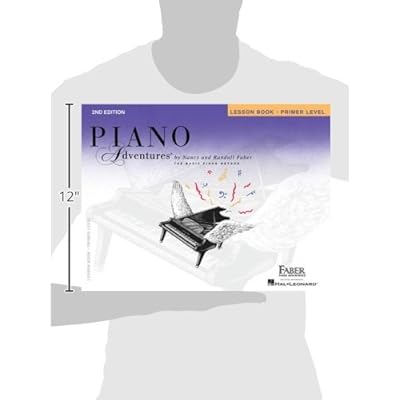Primer Level - Lesson Book: Piano Adventures
Category: Books,Arts & Photography,Music
Primer Level - Lesson Book: Piano Adventures Details
About the Author The husband and wife team Nancy and Randall Faber are internationally known as authors of the Piano Adventures teaching method and over two hundred publications for the piano. They recently founded the Faber Piano Institute in Ann Arbor, MI, where they live with their daughter Vivian. Nancy Faber, who was named "Distinguished Composer of the Year" by the Music Teachers National Association, enjoys a busy schedule of commissions for the concert stage in addition to her educational composing. Recent commissions include "The Snow Queen" for narrator and orchestra, "The Picture My Imagination Has Painted" for Flute Quartet and Piano, and "Trio for Flute, Saxophone and Piano". Her pieces have been heard on U.S. public radio and network television. She studied composition with Joan Tower, William Albright, and British composer Nicholas Maw; piano studies were at the Eastman School and Michigan State University. Randall Faber has toured Korea, Taiwan, Canada and the United Kingdom. He was master teacher for both the World Conference on Piano Pedagogy and the National Conference on Keyboard Pedagogy. He gave recitals in St. Louis, Ann Arbor, as Convention Artist for the North Dakota Music Teachers, and performed as Visiting Artist at the University of Michigan, University of Southern Mississippi, Saginaw State University, and numerous universities throughout South Korea. He was featured clinician for the Nebraska Music Teachers, the Florida Music Teachers and the Pennsylvania Music Teachers Convention, and recently presented his research at the 9th International Conference on Motivation in Lisbon, Portugal. Dr. Faber holds three degrees from the University of Michigan and a Ph.D. from Vanderbilt University. The Fabers advocate piano study not only for personal expression and performance success, but also as a vehicle for the student's creative and cognitive development. Their philosophy is reflected in their writing, their public appearances, and in their own tea Read more

Reviews
I am a piano teacher and I grew up playing the Alfred series. When I started teaching, I used the Alfred series. As I expanded my knowledge of resources out there, I came across this book. In comparison to the Alfred Level 1A book, this one works much better for young beginners. The introduction of notes on the staff is gradual and gives students a chance to absorb 1-3 notes at a time before introducing others (the Alfred book shows all 5 notes in C Position at once and only gives you 1 song for each hand before students are expected to read the grand staff with 5 notes on each staff. For many young beginners, this is overwhelming and they end up struggling with note reading).This book also emphasizes the difference between steps and skips - while you come across a couple 5ths here and there, they are not formally labeled as 5ths. This allows students the chance to get comfortable understanding the staff and the difference between steps and skips before overwhelming them with intervals galore.The first half(ish) of the book is all pre-reading - no staff, just lettered notes and rhythms. I love having the option to use all these pages for younger beginners who need more time to understand the connections between rhythm, the letters of the keys, and their hands. However, for fast learners or some 8-9 year old beginners, we skip some of these songs.Lastly, there are many teacher duets in this book, which are great for (1) spicing up some otherwise bland songs (what can you expect when you only know 2 notes?), (2) helping kids develop their sense of rhythm (we have to count together to stay together!), and (3) allowing beginners to have fun. Almost all my students love playing duets.My students do better when they start with this book rather than the Alfred 1A book. If you have an older beginner, or one with some experience reading music, this book will probably be too easy for them and they'll race right through. But for beginning kids 8-9 and younger, this works like a charm.



